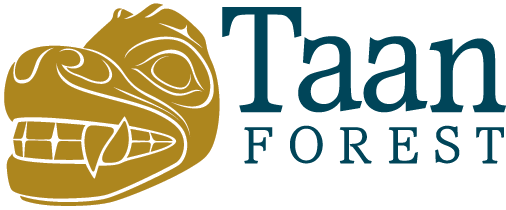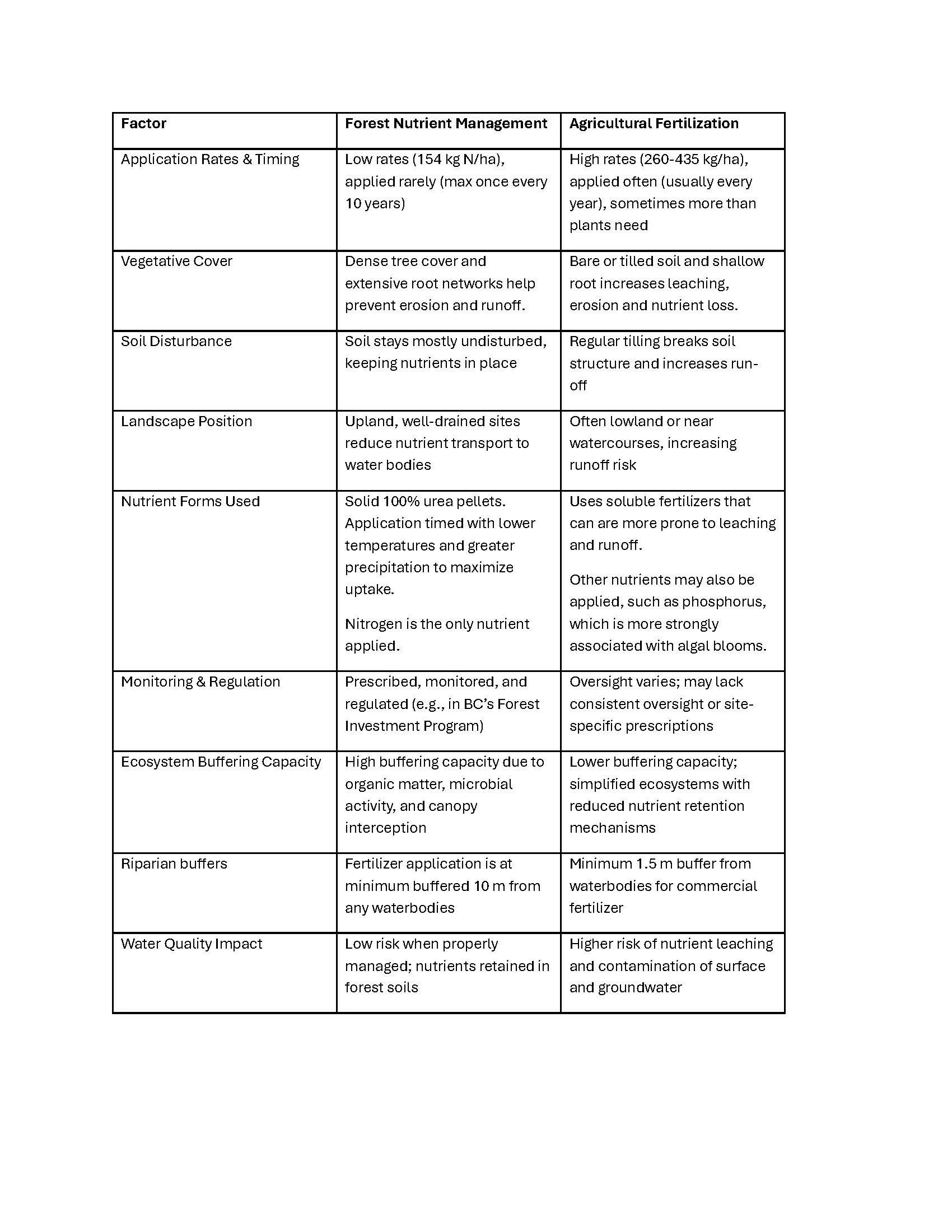Taan Fertilizer Frequently Asked Questions
Forest fertilization is a topic that has been coming up for the past few years from communities and we would like to share information on Taan’s fertilization project.
Taan’s fertilization is 100% nitrogen (urea) and is applied a minimum of 10m away from any waterbody.
To ensure we have significant engagement and approvals, Taan meets every 6 weeks with the Council of the Haida Nation (CHN) Heritage and Natural Resource Department (HNRD) (Taan Operational Advisory Group (TAG)) to review all elements of our operational plans (including fertilization work). All permit applications are reviewed by the CHN–BC Solutions Table and, if required the CHN–BC Integrated Stewardship Team. In addition, through the Province of BC’s Forest Investment Program, our applications and community raised issues are reviewed and approved.
This page is intended to provide clear information about fertilization on Taan Forest tenures: what we’re doing, why we’re doing it, and how it supports healthy forests.
Fertilizer Treatment: Ts’úu | Ts’uu | Western Red Cedar are treasured by the Haida Nation for their cultural and ecological importance. They require careful care and management to ensure their continued growth and dominance in the forest of Haida Gwaii. One critical component of this management strategy involves the application of urea fertilizer to stands of Ts’úu | Ts’uu | Western Red Cedar that are over 15 years of age.
Application Methods and Benefits: At Taan Forest, the method employed for fertilizing Ts’úu | Ts’uu | Western Red Cedar stands involves the hand application of 77 grams of nitrogen pellets to each tree, carefully placed around the drip line. This practice ensures that the fertilizer is delivered precisely where it is needed, maximizing its effectiveness and minimizing any potential application to water. By targeting the drip line, the nutrients are efficiently absorbed by the roots, promoting robust growth and enhancing the tree's ability to sequester carbon. To safeguard the environment, a minimum 10 meter buffer zone is maintained around streams and other waterbodies. Additionally, operations procedures dictate measures for management of any hand spillage and immediate cleanup.
Selection of Treatment Areas: Selecting areas for fertilizer application requires careful consideration of site characteristics to ensure optimal results. Ts’úu | Ts’uu | Western Red Cedar-dominated areas 15 years of age or greater with medium to well-drained soils are prime candidates for fertilization. Such sites support healthy root systems and facilitate the efficient uptake of nutrients and can sequester the most carbon when fertilized. Indications of nutrient deficiencies in these trees can include chlorotic leaves, which exhibit yellowing due to insufficient chlorophyll production. This symptom often points to a lack of essential nutrients such as nitrogen, phosphorus, or potassium. Identifying and addressing these deficiencies through targeted fertilization can significantly enhance tree vitality and growth. All of Taan’s treatment areas are reviewed by the CHN-BC Solutions Table and CHN-BC Integrated Stewardship Team prior to treatment.
A recent Taan brochure had stated: ‘Fertilization is done carefully, always 10 meters away from streams, and only in areas already harvested—following the Haida Gwaii Land Use Objectives Order (HG LUOO).’ The intent was to highlight Taan’s commitment to protecting water and aligning with HG LUOO standards. To clarify: Taan fertilizes stands harvested both before and after the HG LUOO came into effect. Regardless of harvest timing, fertilization is always carried out with care and respect for water resources, maintaining at least a 10-meter buffer from waterbodies. Additionally, Taan has committed to strengthening its approach. Any HG LUOO feature identified in planning/treatment phases that was not previously identified (such as in older stands harvested before HG LUOO) —now receives a protective buffer during treatment.
How does nitrogen fertilizer impact nearby streams and water quality, especially through run-off? In the case of forest nutrient management, less than 3% of nitrogen is leached from the upper mineral soil horizon. Water quality monitoring is regularly conducted in drainages being fertilized in B.C. and has been for several decades. To date no adverse effects on aquatic ecosystem life or the quality of drinking water have been identified through monitoring. To protect water quality streams, wetlands and lakes are buffered with no-treatment zones. Long-term water testing in B.C. has shown no harm to aquatic life or drinking water from these treatments. For reference, the B.C. Ministry of Environment allows up to:
10mg/L of nitrate in drinking water
32.8mg/L for shot-term exposure in aquatic life
3.0 mg/L for long-term exposure in aquatic life
Monitoring in B.C. has never shown levels above 1mg/L, which is well below these limits.
Aquatic Ecosystem Health: Does fertilizer increase the risk of algae blooms in streams, potentially impacting fish habitat/oxygen levels? Water quality monitoring is regularly conducted in drainages being fertilized in B.C., this data has not shown that using urea in B.C. forests causes algal blooms in lakes, streams or oceans. Small amounts of nitrogen help ecosystems grow. Water in fertilized areas across the Province has been tested for decades, and harmful effects have not been identified.
Why not let alder grow naturally instead of removing it? Allowing alder to grow naturally does add nitrogen to the soil, but most of that nitrogen is used by the tree and released very slowly—primarily 15–20 years after establishment. In contrast, urea fertilizer provides immediately available nitrogen, enabling rapid early growth and significant carbon sequestration within the first decade. This early carbon capture is critical for mitigating climate change because it removes atmospheric carbon before further damage occurs, that is why BC provides funding opportunities for this work.
The most effective approach combines both strategies: urea for short-term carbon storage and alder for long-term soil fertility and ecosystem resilience. This dual method maximizes climate benefits across different time horizons, ensuring immediate impact while strengthening the site’s health for the future.
How far can fertilizer nutrients travel from where they are applied? Trees may share nutrients through underground fungal networks. How widespread and important these networks are is still being researched. Nearby trees are the most likely to share resources. This means that if nitrogen is added, the network could help spread it across the stand, making fertilization even more effective. There is not currently evidence that nutrients migrate over substantial distances. Taan Forest maintains buffer zones around waterbodies as an additional precaution.
Longevity: How long do fertilizer pellets stay active in the environment? How long urea pellets last depends on soil type, weather and ground cover. Urea starts breaking down within a few days, and can be fully dissolved within 5 to 10 days.
Fertilization and wood quality: Fertilizing Ts’úu | Ts’uu | Western Red Cedar helps young trees grow faster and stronger, especially in the first few years. This early growth creates wider rings near the center of the tree (the heartwood). Fertilization is done carefully and only in areas already harvested, following the Haida Gwaii Land Use Objectives Order. It helps Ts’úu | Ts’uu | Western Red Cedar grow above competing species, helping to ensure future stands of cultural and monumental cedar are grown.
How does fertilizer used in forestry applications compare to other applications such as agricultural uses?
Resources:
Boyer, C. R. (2023). Evaluating the effects of nitrogen urea fertilization on western redcedar growth, soil carbon stocks, and greenhouse gas emissions on Haida Gwaii, B.C. (Master’s thesis, University of British Columbia). University of British Columbia Library. https://open.library.ubc.ca/cIRcle/collections/ubctheses/24/items/1.0429368
De Montigny, L. & de Jong, R.J., 1998. Effects of thinning and fertilizing mixed western hemlock–Sitka spruce stands. Victoria, B.C.: British Columbia Ministry of Forests, Research Branch. Available at: https://agris.fao.org/search/en/providers/122535/records/65ddd2884c5aef494fd5ef01
Doyle, F. I., Bennett, J., & Chrobot, L. (2024). Stads K’un habitat restoration scoping assessment: Managing for old growth structural attributes. Prepared for Ecosystems Section, Strategic Land Use, West Coast Region, Ministry of Water, Land, and Resource Stewardship. Terrace Community Forest. http://terracecommunityforest.com/wp-content/uploads/2025/01/Stads-Kun-Habitat-Restoration-Scoping-Assessment_2024.pdf
McDonald, M. A., Hawkins, B. J., Prescott, C. E., & Kimmins, J. P. (1994). Growth and foliar nutrition of western red cedar fertilized with sewage sludge, pulp sludge, fish silage, and wood ash on northern Vancouver Island. Canadian Journal of Forest Research, 24(2), 30–83. https://doi.org/10.1139/x94-042
Prescott, C. E., & Weetman, G. F. (1994). Salal cedar hemlock integrated research program: A synthesis of research and management. Canadian Journal of Forest Research, 24(5), 865–881. https://doi.org/10.1139/x94-042
Prescott, C. E., & Zabek, L. M. (1995). Growth response and nutrient availability in western redcedar plantations following amendment with fish–wood compost and straw. Salal Cedar Hemlock Integrated Research Program Report. University of British Columbia. Retrieved from https://schirp.forestry.ubc.ca/publications/%22https:/schirp.sites.olt.ubc.ca/files/2019/05/Prescott-Zabek-Growth-response-and-nutrient-availability.pdf
Need more information? Please reach out!
Phone: 250-559-2337,
Email: Info@taanforest.com or Concerns@taanforest.com
Address: 848 Highway 16, Commercial Centre, Skidegate, Haida Gwaii. V0T 1S1

